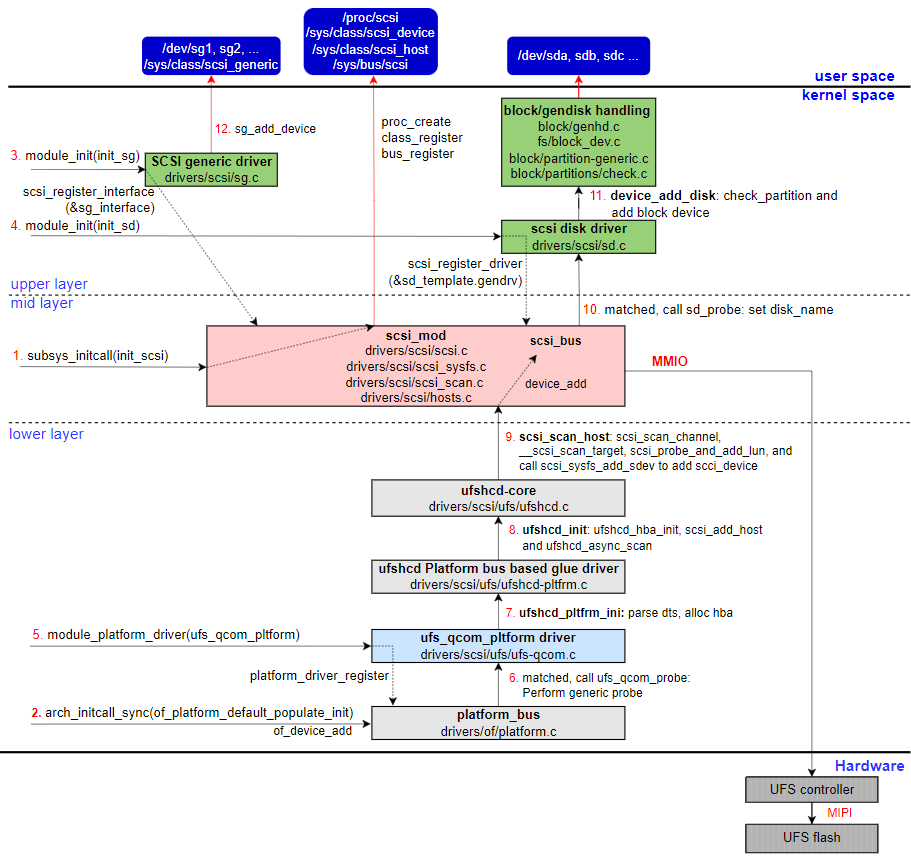Overview
本文简要介绍了 Linux SCSI UFS(Universal Flash Storage) 的初始化。契机是解一个 kernel boot 阶段 mount rootfs 失败的的问题: “VFS: Unable to mount root fs on unknown-block(8,6)”。所以,本文最后也介绍了这个问题的原因和解法。
SCSI UFS init view

Rootfs mount issue
在某一个项目中,我们使用 UFS LUN0 的 partition 6 作为 rootfs 的分区,启动参数是 “root=/dev/sda6”。但是在 Kernel 启动过程中,有较大概率发现此分区的分配盘符是 “/dev/sdb6”, 从而导致系统 panic: “VFS: Unable to mount root fs on unknown-block(8,6)”。
SCSI UFS 初始化过程中,循环给每个 LUN 注册 scsi_device, 然后匹配 scsi_driver 从而调用 sd_probe 分配 index(sda, sdb, …) 添加 block device。每个 LUN 是顺序添加,但是 sd_probe 是异步执行,这样就导致在 sd_probe 中分配的 index 可能失序,LUN0 所获分配的 index 是 sdb,其 partition 6 盘符就是sdb6, 导致 kernel 因为找不到 sda6 而挂载 rootfs 失败。
<drivers/scsi/sd.c>
static struct scsi_driver sd_template = {
.gendrv = {
.name = "sd",
.owner = THIS_MODULE,
.probe = sd_probe,
.probe_type = PROBE_PREFER_ASYNCHRONOUS,
.remove = sd_remove,
.shutdown = sd_shutdown,
.pm = &sd_pm_ops,
},
.rescan = sd_rescan,
.init_command = sd_init_command,
.uninit_command = sd_uninit_command,
.done = sd_done,
.eh_action = sd_eh_action,
.eh_reset = sd_eh_reset,
};
考虑到循环扫描 LUN,添加 scsi_device 是在一个 worker 执行,可以保证顺序,我一开始的解法是:将给每个 LUN 分配 index 挪到注册 scsi_device 的时候,这样就能保证盘符不会失序,从而解决了问题。
之后将这个 patch 提到了 Linux SCSI subsystem 社区 https://patchwork.kernel.org/project/linux-scsi/patch/20220401005928.24140-1-quic_jianguos@quicinc.com/, 被大牛们拒绝了,原因是 Kernel 已有更好的解决方案:
Specifying a /dev/sd* device name as root device is wrong since such a name will change if a disk is added to the system or removed from the system. Please use one of the /dev/disk/by-/ names as root device.
后来在 name_to_dev_t 函数的注释中也找到了相同的答案,这告诉我们:要注意读内核中的 comments,他们和代码一样重要,可能有你需要的答案!
init/do_mounts.c
/*
* Convert a name into device number. We accept the following variants:
*
* 1) <hex_major><hex_minor> device number in hexadecimal represents itself
* no leading 0x, for example b302.
* 2) /dev/nfs represents Root_NFS (0xff)
* 3) /dev/<disk_name> represents the device number of disk
* 4) /dev/<disk_name><decimal> represents the device number
* of partition - device number of disk plus the partition number
* 5) /dev/<disk_name>p<decimal> - same as the above, that form is
* used when disk name of partitioned disk ends on a digit.
* 6) PARTUUID=00112233-4455-6677-8899-AABBCCDDEEFF representing the
* unique id of a partition if the partition table provides it.
* The UUID may be either an EFI/GPT UUID, or refer to an MSDOS
* partition using the format SSSSSSSS-PP, where SSSSSSSS is a zero-
* filled hex representation of the 32-bit "NT disk signature", and PP
* is a zero-filled hex representation of the 1-based partition number.
* 7) PARTUUID=<UUID>/PARTNROFF=<int> to select a partition in relation to
* a partition with a known unique id.
* 8) <major>:<minor> major and minor number of the device separated by
* a colon.
* 9) PARTLABEL=<name> with name being the GPT partition label.
* MSDOS partitions do not support labels!
*
* If name doesn't have fall into the categories above, we return (0,0).
* block_class is used to check if something is a disk name. If the disk
* name contains slashes, the device name has them replaced with
* bangs.
*/
dev_t name_to_dev_t(const char *name)
{
char s[32];
References
SCSI Interfaces Guide — The Linux Kernel documentation Universal Flash Storage — The Linux Kernel documentation https://elinux.org/images/6/64/Introduction_to_UFS.pdf